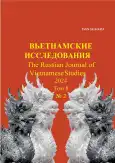Синтетическая классификация провинций и городов Вьетнама как основа региональной политики
- Авторы: Бондаренко К.А.1, Афонина А.Г.2
-
Учреждения:
- НИУ «Высшая школа экономики»
- Университет Людвига-Максимилиана
- Выпуск: Том 8, № 2 (2024)
- Страницы: 19-36
- Раздел: Научные исследования
- URL: https://ogarev-online.ru/2618-9453/article/view/263072
- DOI: https://doi.org/10.54631/VS.2024.82-568651
- ID: 263072
Цитировать
Полный текст
Аннотация
Вьетнам – страна с относительно высоким уровнем регионального неравенства. Статистическое управление Вьетнама группирует провинции, исходя из их географического положения. В данной статье представлена классификация провинций и городов Вьетнама не только на основе географии, но также их социально-экономических характеристик, структуры экономики и участия в свободных экономических зонах (СЭЗ). В ходе анализа выделены четыре группы провинций и городов: i) высокоразвитые (участники СЭЗ с высоким ВРП на душу населения и развитой промышленностью); ii) развитые (участники СЭЗ с высоким нереализованным потенциалом экономического роста и крайне диверсифицированной экономической базой); iii) cреднеразвитые (с достаточно развитым первичным сектором и высоким потенциалом развития туристического сектора) и iv) менее развитые (наиболее бедные регионы). В статье отмечены отдельные провинции, уровень социально-экономического развития которых (при прочих равных условиях) позволит им в ближайшее время перейти в группу более развитых. В целях сокращения неравенства в других провинциях могут быть использованы подходы, успешно реализованные в группах высокоразвитых и развитых – такие как льготы иностранным инвесторам или налоговые преференции для развития особо значимых отраслей.
Ключевые слова
Полный текст
Открыть статью на сайте журналаОб авторах
Ксения Андреевна Бондаренко
НИУ «Высшая школа экономики»
Автор, ответственный за переписку.
Email: xenabondarenko@gmail.com
ORCID iD: 0000-0003-0550-6361
к. э. н., доцент, факультет мировой экономики и мировой политики
Россия, МоскваАнгелина Геннадьевна Афонина
Университет Людвига-Максимилиана
Email: afoninalina2001@gmail.com
ORCID iD: 0009-0001-3143-1693
магистрант
Германия, МюнхенСписок литературы
- Вьетнам – торговый и инвестиционный партнёр: Справочник. М.: ИКСА РАН. 2022. 388 стр. с илл.
- Григорьев Л. М., Урожаева Ю. В., Иванов Д. С. Синтетическая классификация регионов: основа региональной политики // Российские регионы: экономический кризис и проблемы модернизации / Под ред. Л. М. Григорьева, Н. В. Зубаревич, Г. Р. Хасаева. М.: ТЕИС, 2011. С. 34–53.
- Данг Хоанг Линь, Нгуен Тхи Тхань Лам. Геоэкономическое положение Вьетнама: преимущества и проблемы // Вьетнамские исследования. 2022. Т. 6. № 4. С. 23–32.
- Костюнина Г. М. Свободные экономические зоны в практике Вьетнама // Юго-Восточная Азия: актуальные проблемы развития. 2018. №2. С. 121–135.
- Мазырин В. М. Вьетнам: постсоциалистический «тигр» // Мировая экономика и международные отношения. 2012. №. 2. С. 91–104.
- Мазырин В. М. Экономика Вьетнама на подъеме: тенденции 2013–2014 гг. // Вьетнамские исследования. 2015. Т. 1. №. 5. С. 182–207.
- Никулина Е. В. О проблемах написания вьетнамских топонимов и антропонимов в русском языке //Вьетнамские исследования. 2022. Т. 6. №. 4. С. 61–69.
- An R. Vietnam’s Southern Key Economic Region: Opportunities for Investment // Vietnam Briefing. 25.06.2020.
- Celi, G., & Sica, E. Globalization and internal migration: evidence from inter-provincial mobility in Vietnam. Regional Studies, Regional Science. 2023. No. 10(1). P. 1–19.
- Dollar D. Economic reform, openness, and Vietnam's entry into ASEAN //ASEAN Economic Bulletin. 1996. С. 169–184.
- Dollar D., Kraay A. Trade, growth, and poverty // The economic journal. 2004. Т. 114. №. 493. С. F22–F49.
- General Statistics Office of Vietnam (GSO). 2015–2022.
- Huei C.B. The second Age of Asia’s Tiger Cubs // EMSNOW. 2022.
- Huang S. Do green financing and industrial structure matter for green economic recovery? Fresh empirical insights from Vietnam // Economic Analysis and Policy. 2022. V. 75. P. 61–73.
- Le Dang Doanh. The past and the hopeful future of Vietnam’s economy // Asian Management Insights. 2015. Т. 2. №. 1. С. 28.
- Ngo T.H.L., Santos P. Geography and economic growth in Vietnam / Int. Association of Agricultural Economists (IAAE) Triennial Conference, Foz do Iguau, Brazil, 18-24 August, 2012.
- Nguyen N.T. Anh. Regional determinants of FDI location in Vietnam //Journal of Economic Development. 2016. Т. 18. С. 19–37.
- Shira D. Investment Environment in Mekong // Vietnam Briefing, 2022
- World Bank. World Development Report: Reshaping Economic Geography. 2009.
- World Bank. World development indicators. GDP per capita (constant 2015 US$). 2023. URL: https://databank.worldbank.org/source/world-development-indicators#
Дополнительные файлы













